Assessing the Coordination Development Level of Agricultural Economy and Ecology in China: Regional Disparities, Dynamics, and Barriers
Abstract
1. Introduction
2. Literature Review
2.1. Theoretical Foundations of the Coupling-Coordination Mechanism Between the Agricultural Economy and Ecosystem
2.2. Development of Evaluation Index Systems for the Agricultural Economy and Ecosystem
2.3. Empirical Studies on the Coupling and Coordination of the Agricultural Economy and Ecosystem
3. Research Design
3.1. Research Object and Data Sources
3.2. Construction of the Evaluation Index System
3.2.1. Agricultural Economy Evaluation Indicators
3.2.2. Agricultural Ecosystem Evaluation Indicators
3.3. Research Methods
3.3.1. Entropy-Weighted Comprehensive Evaluation Method
- (1)
- Standardization of Original Data:
- (2)
- Calculation of the Proportion of Indicator b in Year a:
- (3)
- Calculation of the Entropy Value for Indicator b:
- (4)
- Calculation of the Divergence Coefficient for Indicator b:
- (5)
- Determination of the Weight for Indicator b:
- (6)
- Calculation of the Comprehensive Development Index:
3.3.2. Modified Coupling Coordination Degree Model
3.3.3. Dagum Gini Coefficient
3.3.4. Kernel Density Estimation
3.3.5. Markov Chain
3.3.6. Obstacle Degree Model
4. Results and Analysis
4.1. Analysis of Coupling Coordination Measurement Results
4.1.1. Overall Characteristics
4.1.2. Provincial and Regional Characteristics
4.2. Decomposition of Regional Differences in Coupling Coordination Degree
4.2.1. Overall Differences
4.2.2. Intra-Regional Differences
4.2.3. Inter-Regional Differences
4.2.4. Sources and Contributions of Disparities
4.3. Dynamic Evolution Trends of Coupling Coordination Degree
4.3.1. Kernel Density Estimation Analysis
4.3.2. Traditional Markov Chain Analysis
4.3.3. Spatial Markov Chain Analysis
4.4. Obstacle Factor Analysis
4.4.1. Analysis of Agricultural Economic System Obstacles
4.4.2. Analysis of Agricultural Ecological System Obstacles
5. Conclusions and Discussion
5.1. Conclusions
5.2. Discussion
5.3. Recommendations
5.4. Limitations and Prospects
Supplementary Materials
Author Contributions
Funding
Institutional Review Board Statement
Data Availability Statement
Acknowledgments
Conflicts of Interest
References
- He, H.; Zhang, Z.; Ding, R.; Shi, Y. Multi-Driving Paths for the Coupling Coordinated Development of Agricultural Carbon Emission Reduction and Sequestration and Food Security: A Configurational Analysis Based on Dynamic fsQCA. Ecol. Indic. 2024, 160, 111875. [Google Scholar] [CrossRef]
- Du, J. Understanding China’s Agricultural Track Record and Food Security. In Farmland, Farming and Food in the National Economy of China, 1947–2020: A Framework for Understanding China’s Agricultural Track Record and Food Security; Du, J., Ed.; Springer Nature Switzerland: Cham, Switzerland, 2024; pp. 125–138. [Google Scholar]
- Ahvo, A.; Heino, M.; Sandstrom, V.; Chrisendo, D.; Jalava, M.; Kummu, M. Agricultural Input Shocks Affect Crop Yields More in the High-Yielding Areas of the World. Nat. Food 2023, 4, 1037–1046. [Google Scholar] [CrossRef]
- Liu, L.; Zheng, X.; Wei, X.; Kai, Z.; Xu, Y. Excessive Application of Chemical Fertilizer and Organophosphorus Pesticides Induced Total Phosphorus Loss from Planting Causing Surface Water Eutrophication. Sci. Rep. 2021, 11, 23015. [Google Scholar] [CrossRef] [PubMed]
- Jankielsohn, A. Sustaining Insect Biodiversity in Agricultural Systems to Ensure Future Food Security. Front. Conserv. Sci. 2023, 4, 1195512. [Google Scholar] [CrossRef]
- Liu, Q.; Sun, X.; Wu, W.; Liu, Z.; Fang, G.; Yang, P. Agroecosystem Services: A Review of Concepts, Indicators, Assessment Methods and Future Research Perspectives. Ecol. Indic. 2022, 142, 109218. [Google Scholar] [CrossRef]
- Wang, Y.; Chen, H.; Zhang, Y. Spatial Characteristics of Coupling Development of Ecological Protection and Agricultural Economy in China. Sustainability 2023, 15, 9068. [Google Scholar] [CrossRef]
- Ren, F.; Yu, X. Coupling Analysis of Urbanization and Ecological Total Factor Energy Efficiency—A Case Study from Hebei Province in China. Sustain. Cities Soc. 2021, 74, 103183. [Google Scholar] [CrossRef]
- He, H.; Guo, F.; Li, L.; Ding, R. Coupling Relationship and Development Patterns of Agricultural Emission Reduction, Carbon Sequestration, and Food Security. Sci. Total Environ. 2024, 955, 176810. [Google Scholar] [CrossRef] [PubMed]
- Yu, J.; Wu, J. The Sustainability of Agricultural Development in China: The Agriculture–Environment Nexus. Sustainability 2018, 10, 1776. [Google Scholar] [CrossRef]
- DeClerck, F.; Jones, S.; Attwood, S.; Bossio, D.; Girvetz, E.; Chaplin-Kramer, B.; Enfors, E.; Fremier, A.; Gordon, L.; Kizito, F.; et al. Agricultural Ecosystems and Their Services: The Vanguard of Sustainability? Curr. Opin. Environ. Sustain. 2016, 23, 92–99. [Google Scholar] [CrossRef]
- Gamage, A.; Gangahagedara, R.; Gamage, J.; Jayasinghe, N.; Kodikara, N.; Suraweera, P.; Merah, O. Role of Organic Farming for Achieving Sustainability in Agriculture. Farming Syst. 2023, 1, 100005. [Google Scholar] [CrossRef]
- Han, G.; Xu, J.; Zhang, X.; Pan, X. Efficiency and Driving Factors of Agricultural Carbon Emissions: A Study in Chinese State Farms. Agriculture 2024, 14, 1454. [Google Scholar] [CrossRef]
- Kumar, P.; Raj, A.; Kumar, V.A. Approach to Reduce Agricultural Waste via Sustainable Agricultural Practices. In Valorization of Biomass Wastes for Environmental Sustainability: Green Practices for the Rural Circular Economy; Srivastav, A.L., Bhardwaj, A.K., Kumar, M., Eds.; Springer Nature Switzerland: Cham, Switzerland, 2024; pp. 21–50. [Google Scholar]
- Rehman, A.; Farooq, M.; Lee, D.-J.; Siddique, K.H.M. Sustainable Agricultural Practices for Food Security and Ecosystem Services. Environ. Sci. Pollut. Res. 2022, 29, 84076–84095. [Google Scholar] [CrossRef]
- Samim, S.A.; Deng, X.; Li, Z. Climate-Smart Agricultural Practices- Determinants and Impact on Crop Production. New Insights from Afghanistan. Mitig. Adapt. Strat. Glob. Chang. 2024, 29, 91. [Google Scholar] [CrossRef]
- Cheng, Z.; Zhu, M.; Cai, J. Reducing Fertilizer and Pesticide Application through Mandatory Agri-Environmental Regulation: Insights from “Two Zero” Policy in China. Environ. Impact Assess. Rev. 2025, 110, 107716. [Google Scholar] [CrossRef]
- Ingrao, C.; Strippoli, R.; Lagioia, G.; Huisingh, D. Water Scarcity in Agriculture: An Overview of Causes, Impacts and Approaches for Reducing the Risks. Heliyon 2023, 9, e18507. [Google Scholar] [CrossRef]
- Bennett, E.M.; Baird, J.; Baulch, H.; Chaplin-Kramer, R.; Fraser, E.; Loring, P.; Morrison, P.; Parrott, L.; Sherren, K.; Winkler, K.J.; et al. Chapter One—Ecosystem Services and the Resilience of Agricultural Landscapes. In Advances in Ecological Research; Bohan, D.A., Vanbergen, A.J., Eds.; The Future of Agricultural Landscapes, Part II; Academic Press: Cambridge, MA, USA, 2021; Volume 64, pp. 1–43. [Google Scholar]
- Peng, L.; Chen, L.; Dai, H. The Impact of Energy Structure on Agricultural Green Productivity in China. Sci. Rep. 2024, 14, 27938. [Google Scholar] [CrossRef] [PubMed]
- Deng, G.; Jiang, H.; Wen, Y.; Ma, S.; He, C.; Sheng, L.; Guo, Y. Driving Effects of Ecosystems and Social Systems on Water Supply and Demand in Semiarid Areas. J. Clean. Prod. 2024, 482, 144222. [Google Scholar] [CrossRef]
- Jiang, L.; Liu, Y.; Wu, S.; Yang, C. Analyzing Ecological Environment Change and Associated Driving Factors in China Based on NDVI Time Series Data. Ecol. Indic. 2021, 129, 107933. [Google Scholar] [CrossRef]
- Mehta, P. The Impact of Climate Change on the Environment, Water Resources, and Agriculture: A Comprehensive Review. In Climate, Environment and Agricultural Development: A Sustainable Approach Towards Society; Rai, P.K., Rai, S., Eds.; Springer Nature: Singapore, 2024; pp. 189–201. [Google Scholar]
- Liu, Y.; Sun, D.; Wang, H.; Wang, X.; Yu, G.; Zhao, X. An Evaluation of China’s Agricultural Green Production: 1978–2017. J. Clean. Prod. 2020, 243, 118483. [Google Scholar] [CrossRef]
- Sun, Y.; Zhao, Z.; Li, M. Coordination of Agricultural Informatization and Agricultural Economy Development: A Panel Data Analysis from Shandong Province, China. PLoS ONE 2022, 17, e0273110. [Google Scholar] [CrossRef] [PubMed]
- Zhang, Y.; Ji, M.; Zheng, X. Digital Economy, Agricultural Technology Innovation, and Agricultural Green Total Factor Productivity. SAGE Open 2023, 13, 21582440231194388. [Google Scholar] [CrossRef]
- Chen, H.; Qin, S.; Wang, H. Spatial Spillover Effect and Nonlinear Relationship between Factor Misallocation and High-Quality Agricultural Economy: Evidence from 154 Cities in Major Grain-Producing Areas of China. Agriculture 2023, 13, 1922. [Google Scholar] [CrossRef]
- Gao, D. Study on the Coupling Coordination and Obstacle Factors between High-Quality Agricultural Development and Ecological Construction in China. Environ. Res. Commun. 2023, 5, 075004. [Google Scholar] [CrossRef]
- Qing, Y.; Zhao, B.; Wen, C. The Coupling and Coordination of Agricultural Carbon Emissions Efficiency and Economic Growth in the Yellow River Basin, China. Sustainability 2023, 15, 971. [Google Scholar] [CrossRef]
- Hou, J.; Zhang, M.; Li, Y. Can Digital Economy Truly Improve Agricultural Ecological Transformation? New Insights from China. Humanit. Soc. Sci. Commun. 2024, 11, 153. [Google Scholar] [CrossRef]
- Castrillon-Gomez, J.A.; Olivar-Tost, G.; Valencia-Calvo, J. Systems Dynamics and the Analytical Network Process for the Evaluation and Prioritization of Green Projects: Proposal That Involves Participative Integration. Sustainability 2022, 14, 11519. [Google Scholar] [CrossRef]
- Wang, X.; Shao, S.; Li, L. Agricultural Inputs, Urbanization, and Urban-Rural Income Disparity: Evidence from China. China Econ. Rev. 2019, 55, 67–84. [Google Scholar] [CrossRef]
- Luo, L.; Qiao, D.; Zhang, R.; Luo, C.; Fu, X.; Liu, Y. Research on the Influence of Education of Farmers’ Cooperatives on the Adoption of Green Prevention and Control Technologies by Members: Evidence from Rural China. Int. J. Environ. Res. Public Health 2022, 19, 6255. [Google Scholar] [CrossRef] [PubMed]
- Qing, C.; Guo, S.; Deng, X.; Xu, D. Farmers’ Awareness of Environmental Protection and Rural Residential Environment Improvement: A Case Study of Sichuan Province, China. Environ. Dev. Sustain. 2022, 24, 11301–11319. [Google Scholar] [CrossRef]
- Wang, J.; Hu, Y.; Bai, Q.J. Analysis on Coupling Development of Agricultural Eco-Economic System in Yan’an City under the Background of Gully Control and Land Consolidation Project. Chin. J. Appl. Ecol. 2020, 31, 3154–3162. [Google Scholar]
- Jiang, Q.; Li, J.; Si, H.; Su, Y. The Impact of the Digital Economy on Agricultural Green Development: Evidence from China. Agriculture 2022, 12, 1107. [Google Scholar] [CrossRef]
- Liu, F.; Wang, C.; Luo, M.; Zhou, S.; Liu, C. An Investigation of the Coupling Coordination of a Regional Agricultural Economics-Ecology-Society Composite Based on a Data-Driven Approach. Ecol. Indic. 2022, 143, 109363. [Google Scholar] [CrossRef]
- Yao, L.; Halike, A.; Wei, Q.; Tang, H.; Tuheti, B. Research on Coupling and Coordination of Agro-Ecological and Agricultural Economic Systems in the Ebinur Lake Basin. Sustainability 2022, 14, 10327. [Google Scholar] [CrossRef]
- Zhang, Z.; Zhang, Y.; Shao, X. Coupling Coordination Analysis and Spatiotemporal Heterogeneity of the Agricultural Eco-Economic System in the Main Grain-Producing Areas of Jilin Province. Env. Sci Pollut Res 2023, 30, 41782–41793. [Google Scholar] [CrossRef]
- Xiong, C.; Zhang, Y.; Wang, W. An Evaluation Scheme Driven by Science and Technological Innovation—A Study on the Coupling and Coordination of the Agricultural Science and Technology Innovation-Economy-Ecology Complex System in the Yangtze River Basin of China. Agriculture 2024, 14, 1844. [Google Scholar] [CrossRef]
- Borsari, B.; Kunnas, J. Agriculture Production and Consumption. In Responsible Consumption and Production; Leal Filho, W., Azul, A.M., Brandli, L., özuyar, P.G., Wall, T., Eds.; Springer International Publishing: Cham, Switzerland, 2020; pp. 1–11. [Google Scholar]
- Guo, J.; Lyu, J. The Digital Economy and Agricultural Modernization in China: Measurement, Mechanisms, and Implications. Sustainability 2024, 16, 4949. [Google Scholar] [CrossRef]
- Wang, Z.; Zhang, J.; He, Y.; Liu, H. A Study on the Potential of Digital Economy in Reducing Agricultural Carbon Emissions. Heliyon 2024, 10, e31941. [Google Scholar] [CrossRef] [PubMed]
- Guo, C.; Zhang, R.; Zou, Y. The Efficiency of China’s Agricultural Circular Economy and Its Influencing Factors under the Rural Revitalization Strategy: A DEA–Malmquist–Tobit Approach. Agriculture 2023, 13, 1454. [Google Scholar] [CrossRef]
- Liu, W.; Zhou, W.; Lu, L. An Innovative Digitization Evaluation Scheme for Spatio-Temporal Coordination Relationship between Multiple Knowledge Driven Rural Economic Development and Agricultural Ecological Environment—Coupling Coordination Model Analysis Based on Guangxi. J. Innov. Knowl. 2022, 7, 100208. [Google Scholar] [CrossRef]
- Yang, X.; Zhang, D.; Jia, Q.; Zhang, W.; Wang, T. Exploring the Dynamic Coupling Relationship between Agricultural Economy and Agro-Ecological Environment in Semi-Arid Areas: A Case Study of Yulin, China. Sustainability 2019, 11, 2259. [Google Scholar] [CrossRef]
- Luo, L.; Nie, Q.; Jiang, Y.; Luo, F.; Wei, J.; Cui, Y. Spatiotemporal Dynamics and Spatial Spillover Effects of Resilience in China’s Agricultural Economy. Agriculture 2024, 14, 1522. [Google Scholar] [CrossRef]
- Heusler, S.; Dür, W.; Ubben, M.S.; Hartmann, A. Aspects of Entropy in Classical and in Quantum Physics. J. Phys. A Math. Theor. 2022, 55, 404006. [Google Scholar] [CrossRef]
- Ouadfel, S.; Abd Elaziz, M. A Multi-Objective Gradient Optimizer Approach-Based Weighted Multi-View Clustering. Eng. Appl. Artif. Intell. 2021, 106, 104480. [Google Scholar] [CrossRef]
- Li, Y.; Chen, Y. The Spatiotemporal Characteristics and Obstacle Factors of the Coupled and Coordinated Development of Agricultural and Rural Digitalization and Food System Sustainability in China. Front. Sustain. Food Syst. 2024, 8, 1357752. [Google Scholar] [CrossRef]
- Wang, S.; Kong, W.; Ren, L.; Zhi, D.; Dai, B. Research on Misuses and Modification of Coupling Coordination Degree Model in China. J. Nat. Resour. 2021, 36, 793–810. [Google Scholar] [CrossRef]
- Wei, H.; Xue, D.; Huang, J.; Liu, M.; Li, L. Identification of Coupling Relationship between Ecosystem Services and Urbanization for Supporting Ecological Management: A Case Study on Areas along the Yellow River of Henan Province. Remote Sens. 2022, 14, 2277. [Google Scholar] [CrossRef]
- Li, L.; Zhou, Y.; Li, M.; Cao, K.; Tao, Y.; Liu, Y. Integrated Modelling for Cropping Pattern Optimization and Planning Considering the Synergy of Water Resources-Society-Economy-Ecology-Environment System. Agric. Water Manag. 2022, 271, 107808. [Google Scholar] [CrossRef]
- Luo, Z.; Zuo, Q. Evaluating the Coordinated Development of Social Economy, Water, and Ecology in a Heavily Disturbed Basin Based on the Distributed Hydrology Model and the Harmony Theory. J. Hydrol. 2019, 574, 226–241. [Google Scholar] [CrossRef]
- Zhu, C.; Lin, Y.; Zhang, J.; Gan, M.; Xu, H.; Li, W.; Yuan, S.; Wang, K. Exploring the Relationship between Rural Transition and Agricultural Eco-Environment Using a Coupling Analysis: A Case Study of Zhejiang Province, China. Ecol. Indic. 2021, 127, 107733. [Google Scholar] [CrossRef]
- Han, X.; Wang, Y.; Yu, W.; Xia, X. Coupling and Coordination between Green Finance and Agricultural Green Development: Evidence from China. Financ. Res. Lett. 2023, 58, 104221. [Google Scholar] [CrossRef]
- Tan, S.; Liu, Q.; Han, S. Spatial-Temporal Evolution of Coupling Relationship between Land Development Intensity and Resources Environment Carrying Capacity in China. J. Environ. Manag. 2022, 301, 113778. [Google Scholar] [CrossRef] [PubMed]
- Dagum, C. Decomposition and Interpretation of Gini and the Generalized Entropy Inequality Measures. Statistica 1997, 57, 295–308. [Google Scholar]
- Zhang, X.; Zhou, X.; Liao, K. Regional Differences and Dynamic Evolution of China’s Agricultural Carbon Emission Efficiency. Int. J. Environ. Sci. Technol. 2023, 20, 4307–4324. [Google Scholar] [CrossRef]
- Wang, W.; Elahi, E.; Sun, S.; Tong, X.; Zhang, Z.; Abro, M.I. Factors Influencing Water Use Efficiency in Agriculture: A Case Study of Shaanxi, China. Sustainability 2023, 15, 2157. [Google Scholar] [CrossRef]
- Rosenblatt, M. Remarks on Some Nonparametric Estimates of a Density Function. Ann. Math. Stat. 1956, 27, 832–837. [Google Scholar] [CrossRef]
- Senga Kiesse, T.; Corson, M.S. The Utility of Less-Common Statistical Methods for Analyzing Agricultural Systems: Focus on Kernel Density Estimation, Copula Modeling and Extreme Value Theory. Behaviormetrika 2023, 50, 491–508. [Google Scholar] [CrossRef]
- Hu, Y.; Liu, X.; Zhang, Z.; Wang, S.; Zhou, H. Spatiotemporal Heterogeneity of Agricultural Land Eco-Efficiency: A Case Study of 128 Cities in the Yangtze River Basin. Water 2022, 14, 422. [Google Scholar] [CrossRef]
- Peng, X.; Wang, G.; Chen, G. Spatial Distribution of Freshippo Villages under the Digitalization of New Retail in China. Sustainability 2023, 15, 3292. [Google Scholar] [CrossRef]
- Tran, H.; Lokuge, W.; Karunasena, W.; Setunge, S. Markov-Based Deterioration Prediction and Asset Management of Floodway Structures. Sustain. Resilient Infrastruct. 2022, 7, 789–802. [Google Scholar] [CrossRef]
- Liu, N.; Liu, C.; Xia, Y.; Ren, Y.; Liang, J. Examining the Coordination Between Green Finance and Green Economy Aiming for Sustainable Development: A Case Study of China. Sustainability 2020, 12, 3717. [Google Scholar] [CrossRef]
- Hu, W.; Liu, J. The Coupling and Coordination of Urban Modernization and Low-Carbon Development. Sustainability 2023, 15, 14335. [Google Scholar] [CrossRef]
- Xunping, L.; Qiu, R.; Yong, L. Evaluation of regional land use performance based on entropy TOPSIS model and diagnosis of its obstacle factors. Trans. Chin. Soc. Agric. Eng. 2016, 32, 243–253. [Google Scholar]
- Zhang, K.; Shen, J.; He, R.; Fan, B.; Han, H. Dynamic Analysis of the Coupling Coordination Relationship between Urbanization and Water Resource Security and Its Obstacle Factor. Int. J. Environ. Res. Public Health 2019, 16, 4765. [Google Scholar] [CrossRef]
- Wang, X.; Fang, H.; Zhang, F.; Fang, S. The Spatial Analysis of Regional Innovation Performance and Industry-University-Research Institution Collaborative Innovation—An Empirical Study of Chinese Provincial Data. Sustainability 2018, 10, 1243. [Google Scholar] [CrossRef]
- Lei, Z.; Cheng, F.; Xiangming, W. Tourism Development, Spatial Spillover and Economic Growth: An Empirical Evidence from China. Tour. Trib. 2014, 29, 16–30. [Google Scholar]
- Li, C.; Guo, G. The Influence of Large-Scale Agricultural Land Management on the Modernization of Agricultural Product Circulation: Based on Field Investigation and Empirical Study. Sustainability 2022, 14, 13967. [Google Scholar] [CrossRef]
- Jin, S.; Mei, Z.; Duan, K. Coupling Coordination of China’s Agricultural Environment and Economy under the New Economic Background. Agriculture 2022, 12, 1147. [Google Scholar] [CrossRef]
- Van de Vliert, A.; Van Peij, J. Circular Economy Implementation in Dutch Agriculture: Assessing Sustainable Practices and Economic Impact. Law Econ. 2024, 3, 20–31. [Google Scholar]
- De Koeijer, T.J.; Wossink, G.A.A.; Struik, P.C.; Renkema, J.A. Measuring Agricultural Sustainability in Terms of Efficiency: The Case of Dutch Sugar Beet Growers. J. Environ. Manag. 2002, 66, 9–17. [Google Scholar] [CrossRef] [PubMed]
- Ma, W.; Vatsa, P.; Bicknell, K. Transition to Sustainable Agriculture in New Zealand: Challenges and the Way Forward. New Zealand Econ. Pap. 2023, 57, 119–124. [Google Scholar] [CrossRef]
- Tal, A. Israeli Agriculture—Innovation and Advancement. In From Food Scarcity to Surplus: Innovations in Indian, Chinese and Israeli Agriculture; Gulati, A., Zhou, Y., Huang, J., Tal, A., Juneja, R., Eds.; Springer: Singapore, 2021; pp. 299–358. [Google Scholar]
- Mutale, B. Agricultural Water Utilization Efficiency: Israel’s Innovations as Lessons for China’s Arid and Semi-Arid Regions. Int. J. Curr. Res. 2021, 13, 18945–18951. [Google Scholar]
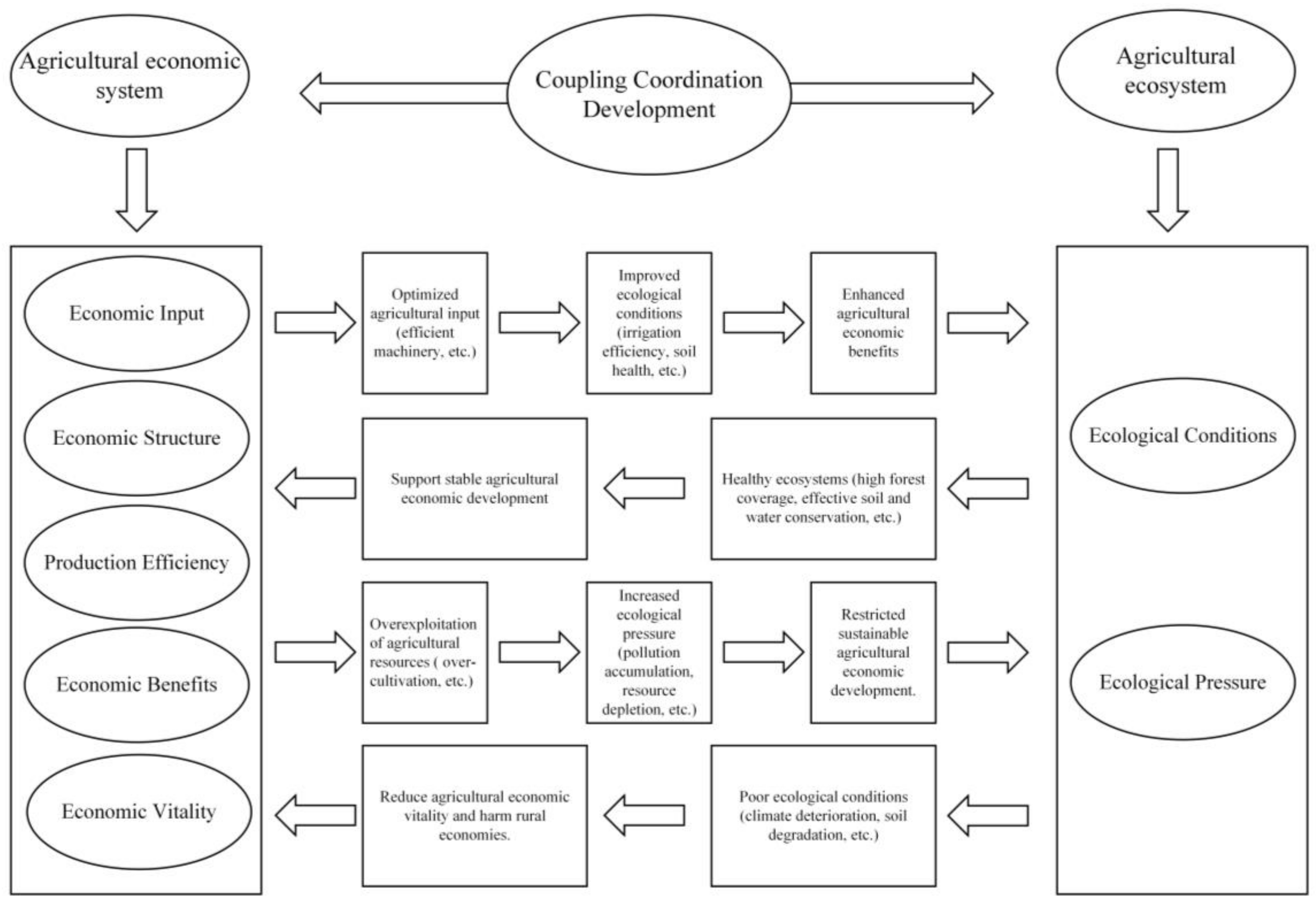

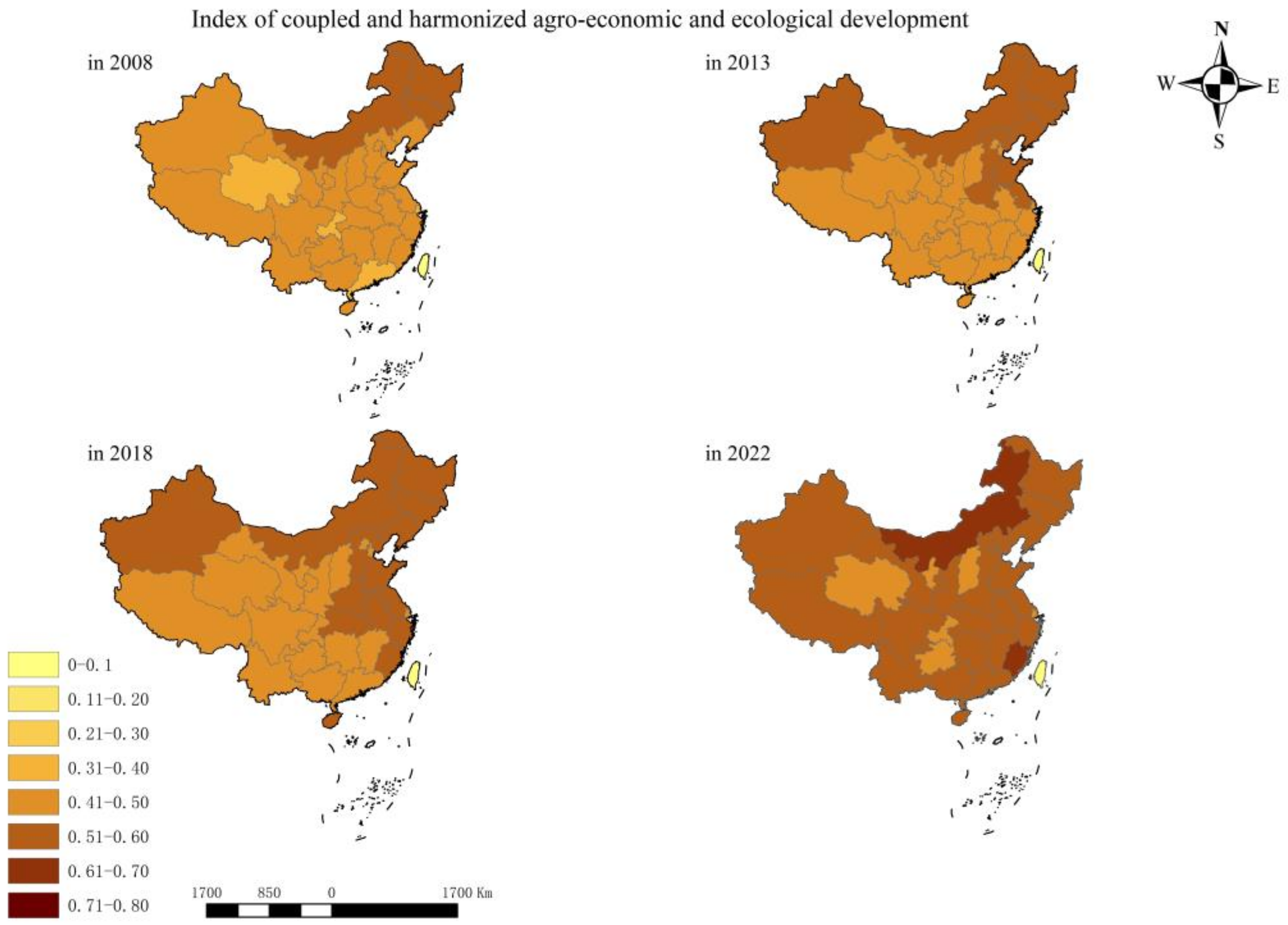
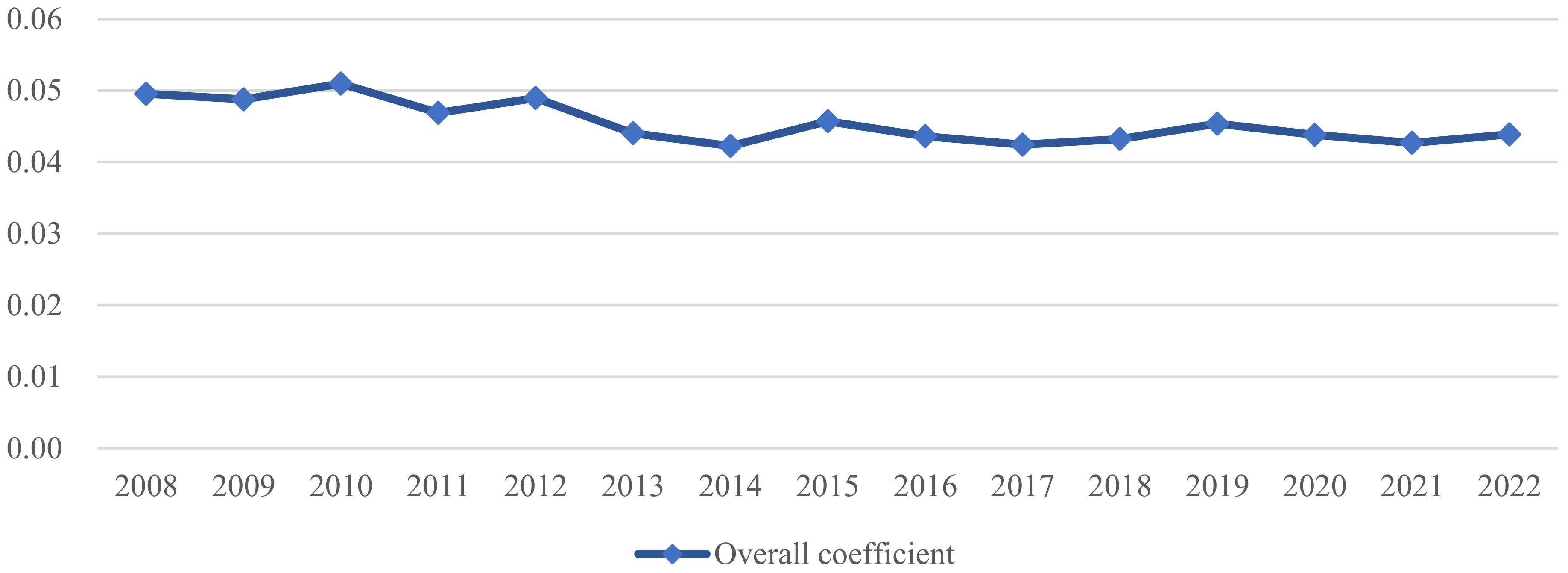
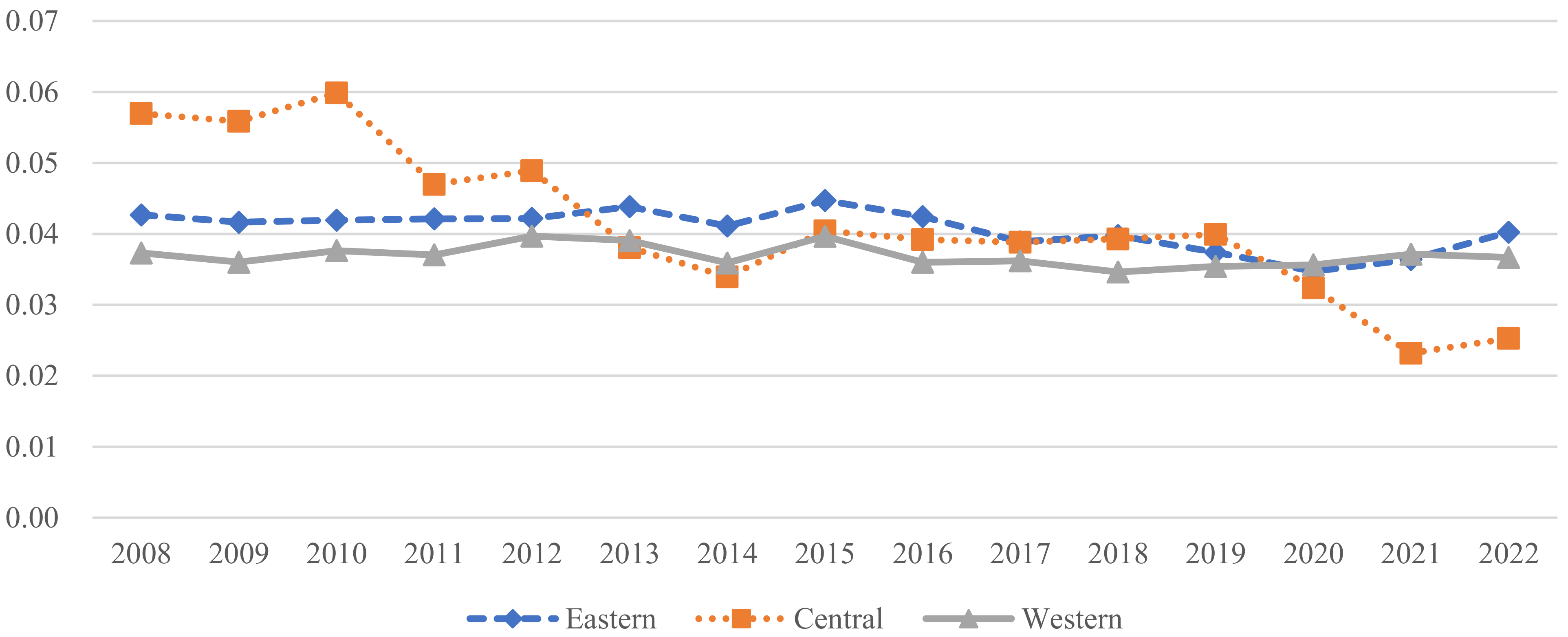

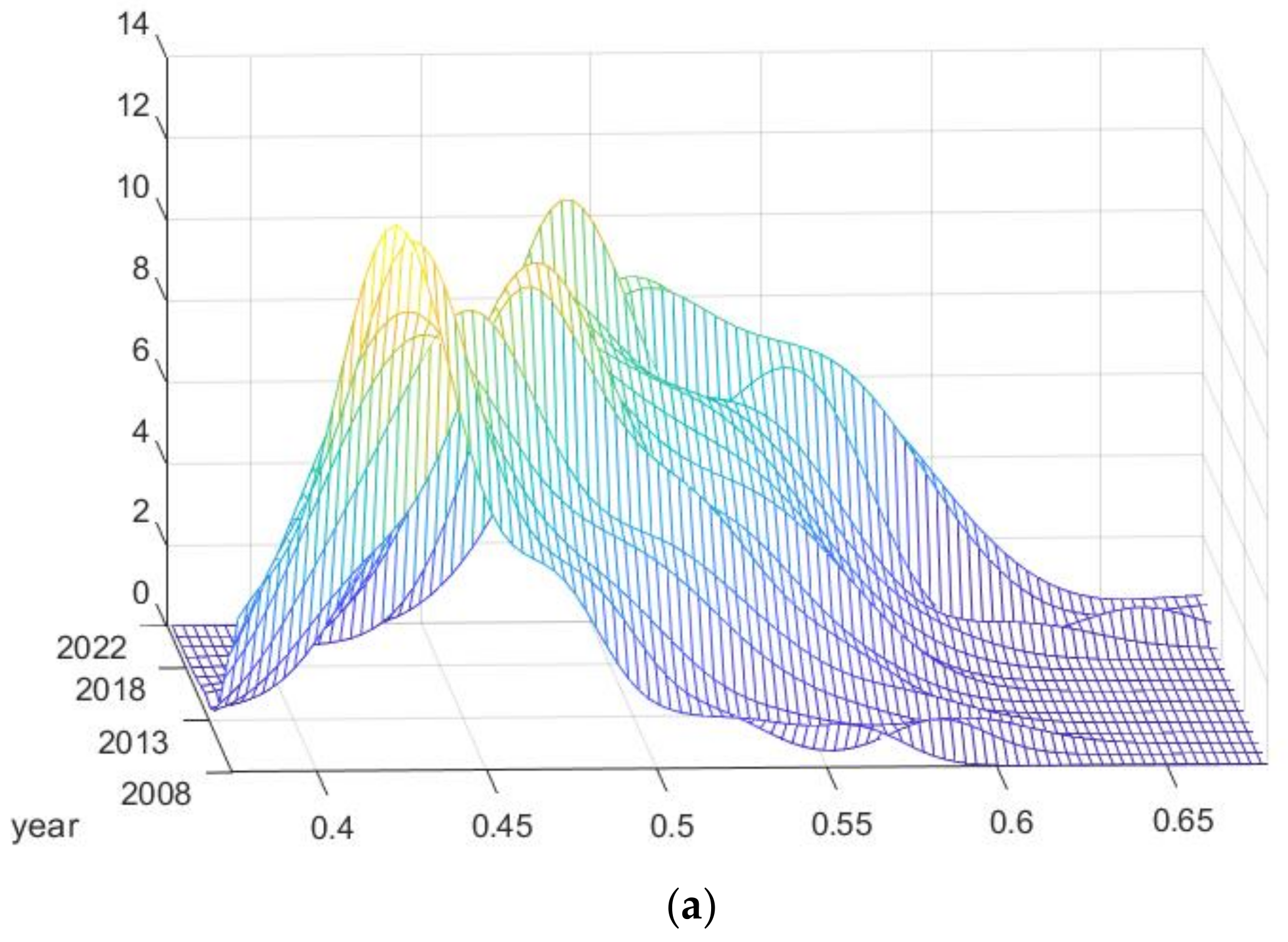
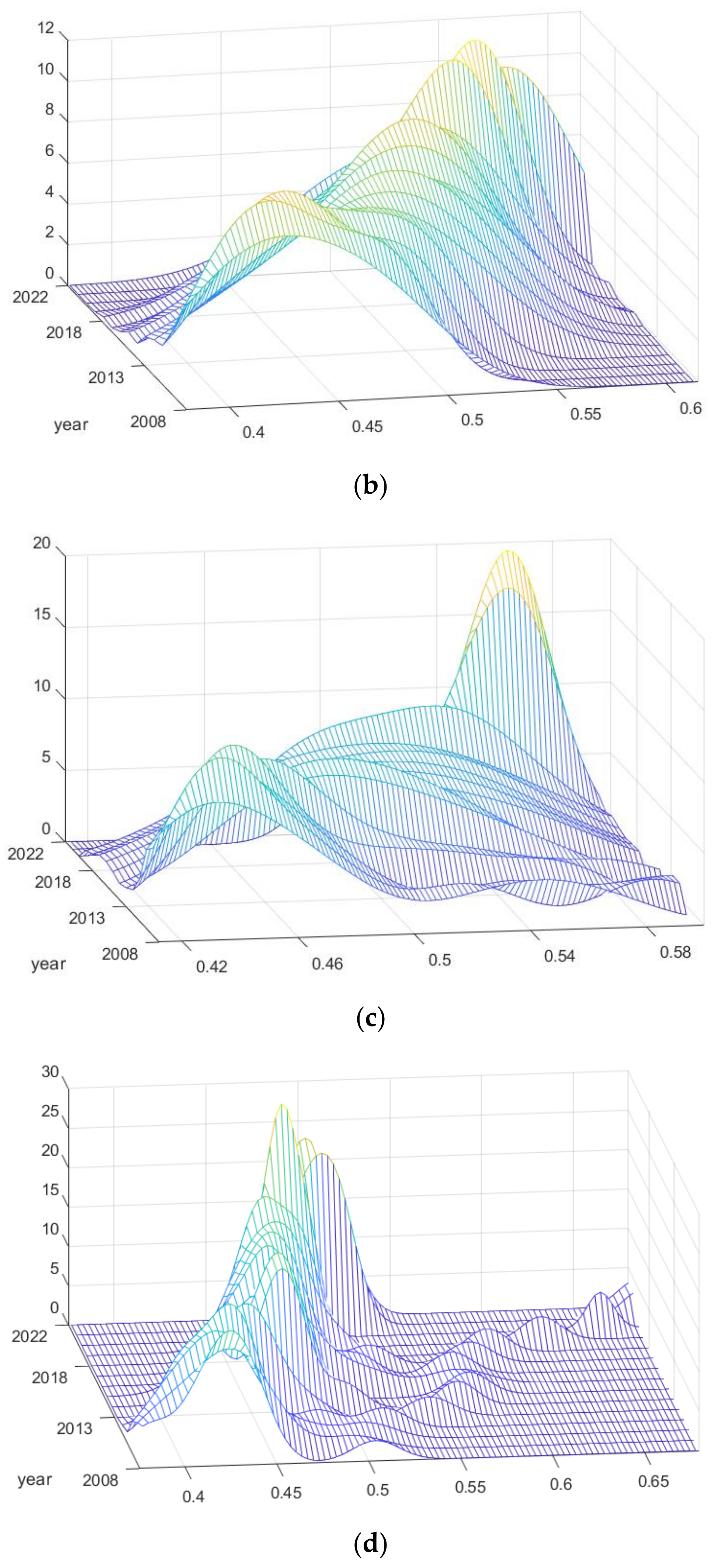
| Region | Scope |
|---|---|
| Eastern | Beijing, Shanghai, Jiangsu, Zhejiang, Tianjin, Hebei, Fujian, Shandong, Guangdong, Hainan, Liaoning |
| Central | Shanxi, Anhui, Jiangxi, Henan, Hubei, Hunan, Jilin, Heilongjiang |
| Western | Inner Mongolia, Guangxi, Chongqing, Sichuan, Guizhou, Yunnan, Tibet, Shaanxi, Gansu, Qinghai, Ningxia, Xinjiang |
| Main Index | First-Tier Indexes | Second-Tier Indexes | Indicator Interpretation | Nature of Indicators | Weight |
|---|---|---|---|---|---|
| Agricultural Economy | Economic Input | Proportion of Employment in the Primary Sector (%) | The percentage of people working in agriculture, forestry, and fishing out of total employment. | Positive | 0.0409 |
| Cultivated Land Area (hm2) | The total area of land suitable for growing crops. | Positive | 0.0980 | ||
| Agricultural Machinery Power per Unit of Sown Area (kW/hm2) | The amount of machinery power available per unit of farmland, showing the level of mechanization. | Positive | 0.0782 | ||
| Economic Structure | Agricultural Industrial Structure Adjustment Index (%) | Evaluates the balance and efficiency of agricultural structure. | Positive | 0.0242 | |
| Proportion of Agricultural Total Output Value (%) | The proportion of agricultural output value in the national economy. | Positive | 0.0483 | ||
| Coordination of Crop Sowing Structure (%) | Reflects the balance between different crop planting areas. | Positive | 0.0351 | ||
| Production Efficiency | Contribution of Primary Industry’s Value Added (%) | The contribution of agriculture to overall economic growth. | Positive | 0.0606 | |
| Agricultural Labor Productivity (%) | Output value per agricultural worker, indicating labor efficiency. | Positive | 0.0713 | ||
| Land Utilization Rate (%) | The proportion of farmland being effectively used. | Positive | 0.1060 | ||
| Volatility of Agricultural Economic Development (%) | Measures the stability or fluctuation of agricultural economic growth. | Positive | 0.0082 | ||
| Scale of Farmland Operation (10,000 people/hm2) | Average size of farmland operated by a single farm or household. | Positive | 0.1205 | ||
| Economic Benefits | Per Capita Grain Output (kg/person) | The average amount of grain available per person. | Positive | 0.0884 | |
| Farmers’ Disposable Income (yuan) | Income that farmers can freely spend or save, reflecting living standards. | Positive | 0.0717 | ||
| Per Capita Total Agricultural Output Value (yuan/person) | The average agricultural output per agricultural worker. | Positive | 0.0650 | ||
| Engel’s Coefficient of Rural Residents (%) | The proportion of food expenses in total spending, showing living standard improvement. | Negative | 0.0255 | ||
| Economic Vitality | Growth Rate of Agricultural GDP (%) | The growth rate of agricultural production value. | Positive | 0.0105 | |
| Urban-Rural Income Gap Index (%) | Reflects the income difference between urban and rural residents. | Negative | 0.0185 | ||
| Growth Rate of Rural Residents’ Net Income (%) | The growth rate of average income for rural residents. | Positive | 0.0200 | ||
| Comparison of Urban-Rural Consumption Levels (%) | Compares spending levels of urban and rural residents. | Negative | 0.0092 |
| Main Index | First-Tier Indexes | Second-Tier Indexes | Indicator Interpretation | Nature of Indicators | Weight |
|---|---|---|---|---|---|
| Agricultural Ecological | Ecological Conditions | Forest Coverage Ratio (%) | The percentage of land covered by forests. | Positive | 0.1369 |
| Irrigation Rate of Cultivated Land (%) | The proportion of farmland with irrigation systems. | Positive | 0.1455 | ||
| Annual Precipitation (mm) | The average amount of rainfall in a year. | Positive | 0.1436 | ||
| Agricultural Water Consumption (m2/person) | The total water used for agricultural production. | Negative | 0.0261 | ||
| Ecological Pressure | Pesticide Use Intensity (t/hm2) | The amount of pesticides used per unit of farmland. | Negative | 0.0186 | |
| Chemical Fertilizer Use Intensity (t/hm2) | The amount of fertilizers applied per unit of farmland. | Negative | 0.0346 | ||
| Agricultural Plastic Film Use Intensity (t/hm2) | The amount of plastic film used for farming purposes. | Negative | 0.0198 | ||
| Agricultural Diesel Use Intensity (t/hm2) | The amount of diesel fuel used per unit of farmland or output value. | Negative | 0.0193 | ||
| Crop Disaster Rate (%) | The percentage of crops affected by natural disasters. | Negative | 0.0254 | ||
| Total Afforestation Area (khm2) | The total area of land turned into forest through planting. | Positive | 0.2166 | ||
| Soil and Water Conservation Treatment Area (khm2) | The area of land treated to prevent soil erosion. | Positive | 0.2136 |
| Coupling Coordination | Coupling Effect Level | Coupling Coordination | Coupling Effect Level |
|---|---|---|---|
| [0.0~0.1) | Severe Imbalance | [0.5~0.6) | Barely Coupled Coordination |
| [0.1~0.2) | Significant Imbalance | [0.6~0.7) | Primary Coupled Coordination |
| [0.2~0.3) | Moderate Imbalance | [0.7~0.8) | Intermediate Coupled Coordination |
| [0.3~0.4) | Mild Imbalance | [0.8~0.9) | Good Coupled Coordination |
| [0.4~0.5) | On the Verge of Imbalance | [0.9~0.10] | High-Quality Coupled Coordination |
| Year | Eastern Region | Central Region | Western Region | National Average |
|---|---|---|---|---|
| 2008 | 0.431 | 0.464 | 0.423 | 0.436 |
| 2009 | 0.437 | 0.471 | 0.425 | 0.441 |
| 2010 | 0.445 | 0.477 | 0.429 | 0.447 |
| 2011 | 0.458 | 0.476 | 0.436 | 0.454 |
| 2012 | 0.471 | 0.489 | 0.447 | 0.466 |
| 2013 | 0.48 | 0.496 | 0.467 | 0.479 |
| 2014 | 0.491 | 0.494 | 0.468 | 0.483 |
| 2015 | 0.497 | 0.503 | 0.475 | 0.49 |
| 2016 | 0.499 | 0.503 | 0.477 | 0.491 |
| 2017 | 0.506 | 0.504 | 0.482 | 0.496 |
| 2018 | 0.513 | 0.509 | 0.485 | 0.501 |
| 2019 | 0.523 | 0.512 | 0.49 | 0.507 |
| 2020 | 0.535 | 0.524 | 0.501 | 0.519 |
| 2021 | 0.556 | 0.548 | 0.522 | 0.541 |
| 2022 | 0.555 | 0.549 | 0.522 | 0.541 |
| Average | 0.493 | 0.501 | 0.47 | 0.486 |
| Year | Overall Coefficient | Intra-Regional Gini Coefficient | Inter-Regional Gini Coefficient | Contribution Rate (%) | ||||||
|---|---|---|---|---|---|---|---|---|---|---|
| Eastern | Central | Western | East-Central | East-West | Central-West | Inter-Regional | Intra-Regional | Transvariation Density | ||
| 2008 | 0.0495 | 0.0427 | 0.0570 | 0.0373 | 0.0583 | 0.0431 | 0.0603 | 38.77 | 29.80 | 31.44 |
| 2009 | 0.0488 | 0.0417 | 0.0559 | 0.0360 | 0.0573 | 0.0419 | 0.0608 | 43.15 | 29.47 | 27.38 |
| 2010 | 0.0510 | 0.0419 | 0.0599 | 0.0376 | 0.0582 | 0.0443 | 0.0649 | 43.93 | 29.28 | 26.78 |
| 2011 | 0.0469 | 0.0421 | 0.0470 | 0.0370 | 0.0483 | 0.0465 | 0.0561 | 40.67 | 29.77 | 29.56 |
| 2012 | 0.0489 | 0.0422 | 0.0489 | 0.0397 | 0.0492 | 0.0502 | 0.0580 | 39.87 | 29.58 | 30.55 |
| 2013 | 0.0440 | 0.0438 | 0.0381 | 0.0391 | 0.0434 | 0.0463 | 0.0473 | 28.97 | 31.48 | 39.55 |
| 2014 | 0.0422 | 0.0411 | 0.0340 | 0.0359 | 0.0394 | 0.0485 | 0.0445 | 29.99 | 30.28 | 39.73 |
| 2015 | 0.0457 | 0.0447 | 0.0404 | 0.0397 | 0.0443 | 0.0501 | 0.0479 | 28.21 | 31.15 | 40.64 |
| 2016 | 0.0436 | 0.0424 | 0.0392 | 0.0360 | 0.0421 | 0.0482 | 0.0466 | 28.50 | 30.58 | 40.92 |
| 2017 | 0.0424 | 0.0389 | 0.0388 | 0.0362 | 0.0399 | 0.0479 | 0.0453 | 26.60 | 30.39 | 43.01 |
| 2018 | 0.0432 | 0.0398 | 0.0393 | 0.0346 | 0.0408 | 0.0500 | 0.0460 | 29.84 | 29.63 | 40.53 |
| 2019 | 0.0454 | 0.0374 | 0.0399 | 0.0354 | 0.0417 | 0.0564 | 0.0478 | 33.68 | 27.92 | 38.40 |
| 2020 | 0.0438 | 0.0347 | 0.0324 | 0.0356 | 0.0367 | 0.0576 | 0.0472 | 35.67 | 27.03 | 37.30 |
| 2021 | 0.0427 | 0.0364 | 0.0232 | 0.0371 | 0.0329 | 0.0567 | 0.0474 | 34.68 | 27.29 | 38.03 |
| 2022 | 0.0439 | 0.0402 | 0.0253 | 0.0367 | 0.0362 | 0.0551 | 0.0495 | 33.19 | 27.85 | 38.95 |
| Lag Type | I | II | III | IV | Observed Value |
|---|---|---|---|---|---|
| I | 0.8103 | 0.1897 | 0 | 0 | 116 |
| II | 0 | 0.7521 | 0.2479 | 0 | 117 |
| III | 0 | 0.0099 | 0.802 | 0.1881 | 101 |
| IV | 0 | 0 | 0.05 | 0.95 | 100 |
| Year | Moran I | Probability | Year | Moran I | Probability |
|---|---|---|---|---|---|
| 2008 | 0.5378 *** | 0.0000 | 2016 | 0.3492 *** | 0.0013 |
| 2009 | 0.5043 *** | 0.0000 | 2017 | 0.2803 *** | 0.0080 |
| 2010 | 0.5615 *** | 0.0000 | 2018 | 0.2749 *** | 0.0090 |
| 2011 | 0.5403 *** | 0.0000 | 2019 | 0.2971 *** | 0.0044 |
| 2012 | 0.5488 *** | 0.0000 | 2020 | 0.2855 *** | 0.0048 |
| 2013 | 0.4200 *** | 0.0001 | 2021 | 0.131 | 0.1441 |
| 2014 | 0.4314 *** | 0.0000 | 2022 | 0.1846 * | 0.0548 |
| 2015 | 0.4164 *** | 0.0001 |
| Lag Type | t/t + 1 | I | II | III | IV | Observed Value |
|---|---|---|---|---|---|---|
| I | I | 0.8514 | 0.1486 | 0 | 0 | 74 |
| II | 0 | 0.8947 | 0.1053 | 0 | 19 | |
| III | 0 | 0 | 0.8 | 0.2 | 5 | |
| IV | 0 | 0 | 0 | 0 | 0 | |
| II | I | 0.7667 | 0.2333 | 0 | 0 | 30 |
| II | 0 | 0.7209 | 0.2791 | 0 | 43 | |
| III | 0 | 0 | 0.8889 | 0.1111 | 36 | |
| IV | 0 | 0 | 0.25 | 0.75 | 4 | |
| III | I | 0.6667 | 0.3333 | 0 | 0 | 9 |
| II | 0 | 0.7234 | 0.2766 | 0 | 47 | |
| III | 0 | 0.0238 | 0.7619 | 0.2143 | 42 | |
| IV | 0 | 0 | 0.0571 | 0.9429 | 35 | |
| IV | I | 0.6667 | 0.3333 | 0 | 0 | 3 |
| II | 0 | 0.75 | 0.25 | 0 | 8 | |
| III | 0 | 0 | 0.7222 | 0.2778 | 18 | |
| IV | 0 | 0 | 0.0328 | 0.9672 | 61 |
| Agricultural Economic System | Agricultural Ecological System | |||||||
|---|---|---|---|---|---|---|---|---|
| First Factor | Second Factor | Third Factor | Fourth Factor | Fifth Factor | First Factor | Second Factor | Third Factor | |
| National | Scale of Farmland Operation (13.80%) | Land Utilization Rate (12.19%) | Cultivated Land Area (9.96%) | Per Capita Grain Output (9.74%) | Agricultural Machinery Power per Unit of Sown Area (8.8%) | Total Afforestation Area (26.6%) | Soil and Water Conservation Treatment Area (26.12%) | Irrigation Rate of Cultivated Land (15.05%) |
| Eastern Region | Scale of Farmland Operation (14.77%) | Cultivated Land Area (11.18%) | Per Capita Grain Output (10.8%) | Land Utilization Rate (10.44%) | Agricultural Machinery Power per Unit of Sown Area (8.2%) | Total Afforestation Area (30.03%) | Soil and Water Conservation Treatment Area (29.15%) | Annual Precipitation (12.58%) |
| Central Region | Land Utilization Rate (13.73%) | Scale of Farmland Operation (13.24%) | Agricultural Machinery Power per Unit of Sown Area (9.81%) | Per Capita Grain Output (8.55%) | Cultivated Land Area (8.37%) | Total Afforestation Area (26.98%) | Soil and Water Conservation Treatment Area (26.83%) | Irrigation Rate of Cultivated Land (15.72%) |
| Western Region | Scale of Farmland Operation (13.28%) | Land Utilization Rate (12.76%) | Cultivated Land Area (9.92%) | Per Capita Grain Output (9.55%) | Agricultural Machinery Power per Unit of Sown Area (8.69%) | Total Afforestation Area (23.21%) | Soil and Water Conservation Treatment Area (22.88%) | Irrigation Rate of Cultivated Land (18.7%) |
Disclaimer/Publisher’s Note: The statements, opinions and data contained in all publications are solely those of the individual author(s) and contributor(s) and not of MDPI and/or the editor(s). MDPI and/or the editor(s) disclaim responsibility for any injury to people or property resulting from any ideas, methods, instructions or products referred to in the content. |
© 2025 by the authors. Licensee MDPI, Basel, Switzerland. This article is an open access article distributed under the terms and conditions of the Creative Commons Attribution (CC BY) license (https://creativecommons.org/licenses/by/4.0/).
Share and Cite
Zhan, L.; Huang, X.; Xu, Z.; Huang, Z. Assessing the Coordination Development Level of Agricultural Economy and Ecology in China: Regional Disparities, Dynamics, and Barriers. Agriculture 2025, 15, 176. https://doi.org/10.3390/agriculture15020176
Zhan L, Huang X, Xu Z, Huang Z. Assessing the Coordination Development Level of Agricultural Economy and Ecology in China: Regional Disparities, Dynamics, and Barriers. Agriculture. 2025; 15(2):176. https://doi.org/10.3390/agriculture15020176
Chicago/Turabian StyleZhan, Lei, Xiaoying Huang, Zihao Xu, and Zhigang Huang. 2025. "Assessing the Coordination Development Level of Agricultural Economy and Ecology in China: Regional Disparities, Dynamics, and Barriers" Agriculture 15, no. 2: 176. https://doi.org/10.3390/agriculture15020176
APA StyleZhan, L., Huang, X., Xu, Z., & Huang, Z. (2025). Assessing the Coordination Development Level of Agricultural Economy and Ecology in China: Regional Disparities, Dynamics, and Barriers. Agriculture, 15(2), 176. https://doi.org/10.3390/agriculture15020176





